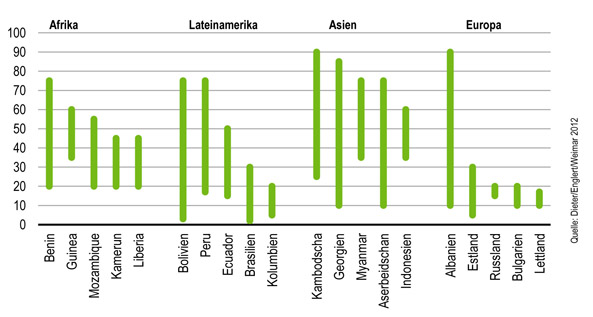According to the FAO, around 4.7 million hectares of forest are destroyed worldwide every year. That is the equivalent of 18,000 football pitches per day. The consequences for the environment: Forests are not managed sustainably, contrary to the standards of forestry practice. Improper harvesting methods damage forest soils. All of this jeopardises biodiversity and the stability of forests. The result is large-scale deforestation and thus increased CO2 emissions. At the same time, valuable forest stands are being lost, which in turn could bind excess CO2. Climate change is progressing.
Illegal logging deprives the affected countries of tax revenues and fees, while at the same time fuelling corruption. The destruction of ecosystems jeopardises the income of the local population in the affected countries. According to World Bank estimates, the global economy loses between ten and 15 billion US dollars every year due to illegal logging. Furthermore, those who trade or process timber products illegally can do so at lower prices. This increases the economic pressure on companies operating in compliance with the law. As a result, sustainable forest management is coming under pressure, including in Germany.

The tropical regions of Asia, Africa, Latin America and Siberia are particularly affected. The figure lists the five most affected countries on four continents.
Due to international trade and the global division of labour, illegally harvested timber can also be contained in timber products imported from countries not directly affected.
The chart shows the five countries most affected by illegal logging in Africa, Latin America, Asia and Europe. Figures in per cent.
The EUTR will be repealed with effect from 30 December 2025. Companies that place relevant raw materials and products on the market in the EU, make them available or export them from the EU must then apply the provisions of the EUDR (EU Deforestation Regulation). For micro, small and medium-sized enterprises, the regulations will only apply from 30 June 2026.
Special transitional rules apply to all wood products that were previously covered by the EUTR. For EUTR products manufactured before 29 June 2023 and placed on the market from 30 December 2025, the EUTR will continue to apply until 31 December 2028. For EUTR products manufactured before 29 June 2023 and placed on the market from 31 December 2028, the new EUDR will apply.
The Federal Office for Agriculture and Food (BLE) is responsible for implementing and enforcing the regulation in Germany. In contrast, the respective state authorities are responsible for monitoring domestic raw materials and products made from cattle, soya and wood.
Further information can be found at the BLE website: www.ble.de/DE/Themen/Wald-Holz/Entwaldungsfreie-Produkte/Lieferketten_node.html (in German)
Do you a have further questions?
Then send us an e-mail and we will try to respond as soon as possible.
holzherkuenfte@thuenen.de





